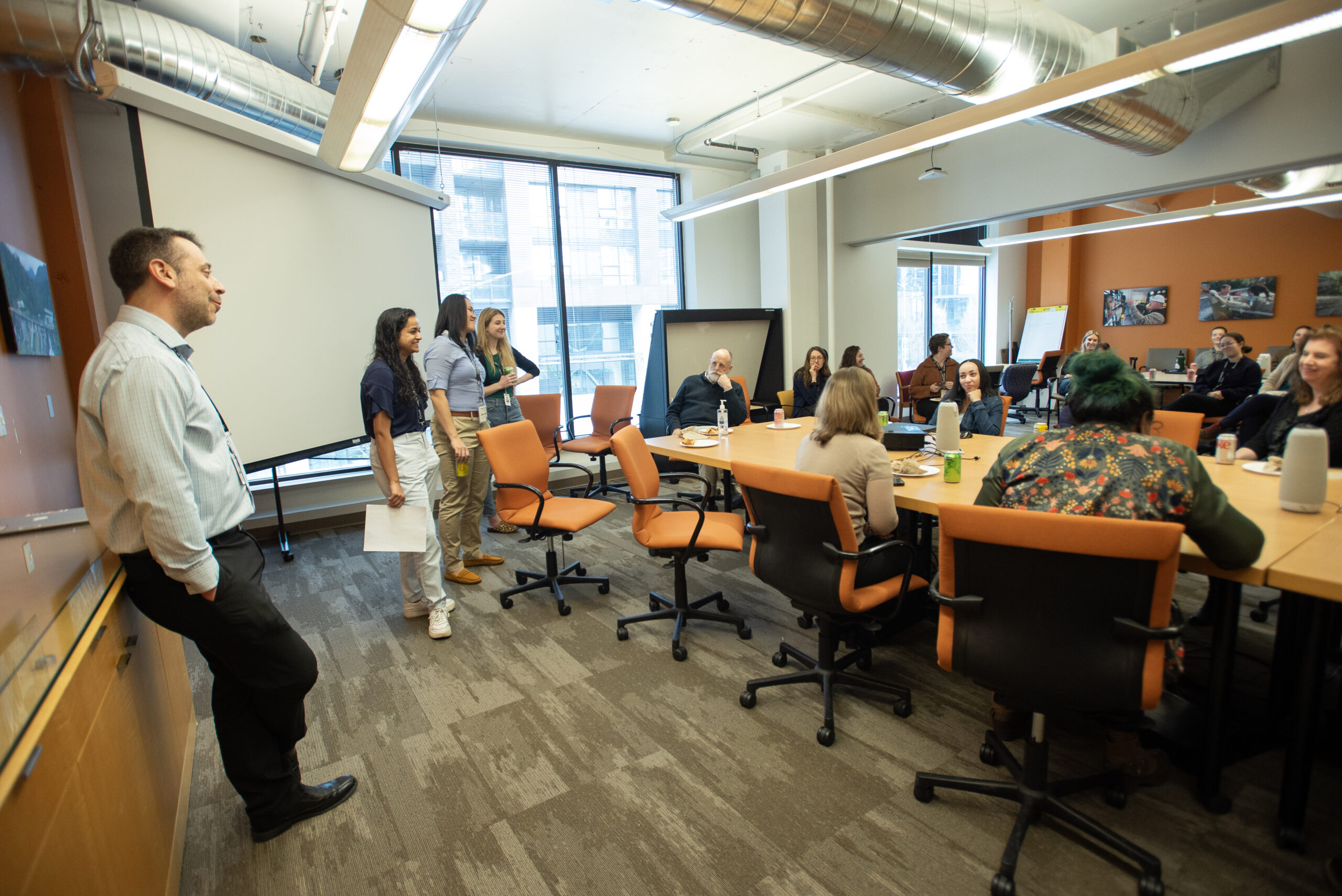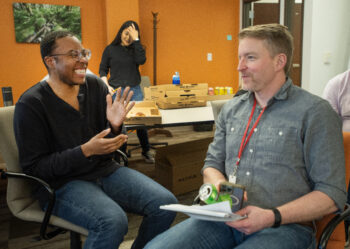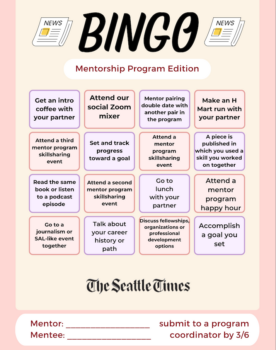5 tips for starting a mentorship program, from The Seattle Times
Emily Ristow, American Press Institute,
Mentors and mentees gather in celebration for the end of the semester mentorship program at The Seattle Times office in March 2024. (Amanda Ray/The Seattle Times)
Here’s an idea to steal and adapt: The Seattle Times’ successful newsroom mentorship program boosts staff engagement and contributes to professional development.This is a series on Better News to a) showcase innovative/experimental ideas that emerge from the Knight-Lenfest Newsroom Initiative and b) share replicable tactics that benefit the news industry as a whole.
This piece features tips from Stefanie Loh, assistant managing editor, and Amanda “Mindy” Ray, multimedia specialist, both at The Seattle Times. The Seattle Times participated in the Major Market Table Stakes program in 2017.
Newsroom mentorship programs can be an attractive strategy for local news organizations looking to increase staff engagement, support professional development and retain talented journalists. But where to start?
In March 2024, the American Press Institute invited Stefanie Loh, who co-leads The Seattle Times’ in-house mentorship program, and former mentee Amanda “Mindy” Ray to speak to alumni of the Table Stakes Local News Transformation Program.
The Times’ six-month mentorship program is a reboot of a mentorship program originally launched in the early 1990s and boasts strong participation, ranging from one-third to just over half of the newsroom taking part in a given cycle over the past three years. In the 2020-21 cycle during the COVID-19 pandemic, 70% of the newsroom participated.
Exit surveys demonstrate the appeal. For the 2022-23 program cycle, all survey respondents said the program was worth their time, 95% said it contributed to their personal development and 94% said they would recommend it to others.
Here are five tips for starting a successful mentorship program in your organization:
Recruit helpers
Launching and maintaining a mentorship program takes time and teamwork.
The Times’ program is run by a four-person committee, led by Loh, an assistant managing editor, and Rebecca Bailey, newsroom operations manager. Each cycle, they’re joined by two former program participants. The committee works best when it is a mix of managers and non-managers and draws from different newsroom departments. Among this group, you want a strong understanding of the strengths and ambitions of the people in the newsroom, as this will help with matching mentees and mentors (more on that below).
Smaller organizations may need to scale down the committee size, but Loh still recommends that at least two people lead the effort as it’s likely too much for one person to juggle along with their regular responsibilities. Loh suggests that smaller organizations in the same region consider partnering on a mentorship program, to both spread out the planning and to increase the pool of potential mentees and mentors.
Set a schedule

Communities reporter Tat Bellamy Walker (left) and Business Editor Levi Pulkkinen, who both participated in the mentorship program, talk during the pizza party in March 2024. (Amanda Ray/The Seattle Times)
Establishing a regular cadence for your mentorship program can be helpful.
The Times has found about six months is a good length. It gives mentees and mentors a chance to develop a rhythm but doesn’t create a burdensome time commitment for participants.
At the Times, the mentorship program kicks off each September with a launch party where pairings are introduced. Mentors and mentees are encouraged to meet every other week. Program coordinators check in with pairings at the start, mid-point and end of the program in March.
Between cycles, the program committee is busy:
- April: Review exit surveys and appoint two new members
- June: Begin meeting weekly to plan for the next cycle
- July: Call for participation goes out to the newsroom
- August: Pair mentees and mentors

Criminal Justice reporter Mike Carter (left) and Morning reporter Vonnai Phair share a conversation about their experience in the mentorship program.(Amanda Ray/The Seattle Times)
Spend time making great matches
“When you’re putting a mentor program together, the program lives or dies by how well you make these pairings,” Loh says.
The Times uses sign-up surveys to help.
Potential mentees share:
- Name 3 people in our newsroom you think would make good mentors for you.
- What comes to mind when you envision your potential mentor?
- What are you hoping to get out of the program?
Potential mentors are asked:
- What skills or experience can you offer a mentee? Please list 5.
- Before your current role, what previous jobs/beats in journalism have you held that you would feel comfortable advising a fellow journalist on?
Those responses and the committee’s knowledge of the strengths, weaknesses and ambitions of the people who make up the newsroom help ensure strong matches.
When making matches, the committee first sees how many “wish list” requests they can fulfill. From there they move to the skills and experience of mentors. At this point, additional mentor recruiting occurs because typically sign-ups bring more potential mentees than mentors.
Some additional tips for good matches:
- Ask people for more information if their survey responses lack the detail you need.
- Try to match people from different departments.
- If you think personalities will mesh, don’t be afraid to make pairings that seem odd on paper.
A good match can also play out in surprising ways. Ray, a former mentee who joined the Times during the COVID-19 pandemic, signed up for the program to connect with colleagues and improve her writing skills.
She was matched with food writer Jackie Varriano, who really took the time to get to know her as a person.
“Emotional-level of bonding with your colleagues and how we can learn to support each other really showed me what this program can do. It inspired me to do that with other colleagues,” Ray says. “(I’ve) taken those skills into my job every day.”
Through their meetings, Varriano encouraged Ray to write a story about a family cookbook project she was working on with a cousin.
Listen to what your newsroom wants
You’ll want to tailor your program to your participants. The sign-up and exit surveys and check-ins with participants are great tools for that.
The Times program includes monthly skills-sharing sessions, inspired by what participants submitted in the sign-up surveys.
Some examples of sessions:
- Career paths in the newsroom
- Time management and organization
- Creative writers’ workshop-style editing session
- Interviewing reluctant sources
- Shoe-leather reporting skills
- How to cultivate sources
Before the pandemic, the mentorship program was an in-person experience. At the peak of the pandemic, it shifted to an entirely virtual experience. Though most sessions and activities are now offered in person again, the Times found that some pandemic-era virtual offerings still work well. For example, they do a Zoom “speed-dating” session toward the beginning of the program cycle. Over an hour, people are randomly assigned to a breakout room with another participant for five minutes. The hour goes quickly as participants cycle through different rooms, and everyone leaves knowing many more people in the newsroom.

Participants of The Seattle Times’ 2022-23 newsroom mentorship program enjoy a get-to-know-you lunch at Cactus, a Mexican restaurant close to the newsroom. (Photo courtesy of Naomi Ishisaka)
Make it fun

The 2023-24 iteration of The Seattle Times newsroom mentorship program included a bingo card to help mentor/mentee pairings come up with activities to do together. (Card created by Anika Varty)
A mentorship program doesn’t need to be all business. The Times builds in plenty of opportunities for fun, including launch and final wrap-up parties, happy hours and group lunches.
The 2023-24 program also introduced a bingo card with mentorship suggestions in each square. The pair who completed all of the activities earned a free day off.